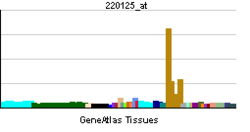- DNAI1
-
Dynein, axonemal, intermediate chain 1 Identifiers Symbols DNAI1; CILD1; ICS; ICS1; MGC26204; PCD External IDs OMIM: 604366 MGI: 1916172 HomoloGene: 8122 GeneCards: DNAI1 Gene Gene Ontology Molecular function • motor activity Cellular component • cytoplasm
• cytoskeleton
• microtubule
• cilium
• dynein complex
• cilium axonemeBiological process • cell projection organization Sources: Amigo / QuickGO RNA expression pattern 
More reference expression data Orthologs Species Human Mouse Entrez 27019 68922 Ensembl ENSG00000122735 ENSMUSG00000061322 UniProt Q9UI46 Q8BMY8 RefSeq (mRNA) NM_012144 NM_175138.4 RefSeq (protein) NP_036276 NP_780347.2 Location (UCSC) Chr 9:
34.46 – 34.52 MbChr 4:
41.52 – 41.59 MbPubMed search [1] [2] Dynein intermediate chain 1, axonemal is a protein that in humans is encoded by the DNAI1 gene.[1][2]
The inner- and outer-arm dyneins, which bridge between the doublet microtubules in axonemes, are the force-generating proteins responsible for the sliding movement in axonemes. The intermediate and light chains, thought to form the base of the dynein arm, help mediate attachment and may also participate in regulating dynein activity. This gene encodes an intermediate chain dynein, belonging to the large family of motor proteins. Mutations in this gene result in abnormal ciliary ultrastructure and function associated with primary ciliary dyskinesia (PCD) and Kartagener syndrome.[2]
References
- ^ Pennarun G, Escudier E, Chapelin C, Bridoux AM, Cacheux V, Roger G, Clement A, Goossens M, Amselem S, Duriez B (Jan 2000). "Loss-of-function mutations in a human gene related to Chlamydomonas reinhardtii dynein IC78 result in primary ciliary dyskinesia". Am J Hum Genet 65 (6): 1508–19. doi:10.1086/302683. PMC 1288361. PMID 10577904. http://www.pubmedcentral.nih.gov/articlerender.fcgi?tool=pmcentrez&artid=1288361.
- ^ a b "Entrez Gene: DNAI1 dynein, axonemal, intermediate chain 1". http://www.ncbi.nlm.nih.gov/sites/entrez?Db=gene&Cmd=ShowDetailView&TermToSearch=27019.
External links
Further reading
- Guichard C, Harricane MC, Lafitte JJ, et al. (2001). "Axonemal dynein intermediate-chain gene (DNAI1) mutations result in situs inversus and primary ciliary dyskinesia (Kartagener syndrome).". Am. J. Hum. Genet. 68 (4): 1030–5. doi:10.1086/319511. PMC 1275621. PMID 11231901. http://www.pubmedcentral.nih.gov/articlerender.fcgi?tool=pmcentrez&artid=1275621.
- Zariwala M, Noone PG, Sannuti A, et al. (2002). "Germline mutations in an intermediate chain dynein cause primary ciliary dyskinesia.". Am. J. Respir. Cell Mol. Biol. 25 (5): 577–83. PMID 11713099.
- Tai CY, Dujardin DL, Faulkner NE, Vallee RB (2002). "Role of dynein, dynactin, and CLIP-170 interactions in LIS1 kinetochore function.". J. Cell Biol. 156 (6): 959–68. doi:10.1083/jcb.200109046. PMC 2173479. PMID 11889140. http://www.pubmedcentral.nih.gov/articlerender.fcgi?tool=pmcentrez&artid=2173479.
- Noone PG, Zariwala M, Sannuti A, et al. (2002). "Mutations in DNAI1 (IC78) cause primary ciliary dyskinesia.". Chest 121 (3 Suppl): 97S. doi:10.1378/chest.121.3_suppl.97S. PMID 11893720.
- Strausberg RL, Feingold EA, Grouse LH, et al. (2003). "Generation and initial analysis of more than 15,000 full-length human and mouse cDNA sequences.". Proc. Natl. Acad. Sci. U.S.A. 99 (26): 16899–903. doi:10.1073/pnas.242603899. PMC 139241. PMID 12477932. http://www.pubmedcentral.nih.gov/articlerender.fcgi?tool=pmcentrez&artid=139241.
- Ficarro S, Chertihin O, Westbrook VA, et al. (2003). "Phosphoproteome analysis of capacitated human sperm. Evidence of tyrosine phosphorylation of a kinase-anchoring protein 3 and valosin-containing protein/p97 during capacitation.". J. Biol. Chem. 278 (13): 11579–89. doi:10.1074/jbc.M202325200. PMID 12509440.
- Ota T, Suzuki Y, Nishikawa T, et al. (2004). "Complete sequencing and characterization of 21,243 full-length human cDNAs.". Nat. Genet. 36 (1): 40–5. doi:10.1038/ng1285. PMID 14702039.
- Humphray SJ, Oliver K, Hunt AR, et al. (2004). "DNA sequence and analysis of human chromosome 9.". Nature 429 (6990): 369–74. doi:10.1038/nature02465. PMC 2734081. PMID 15164053. http://www.pubmedcentral.nih.gov/articlerender.fcgi?tool=pmcentrez&artid=2734081.
- Gerhard DS, Wagner L, Feingold EA, et al. (2004). "The status, quality, and expansion of the NIH full-length cDNA project: the Mammalian Gene Collection (MGC).". Genome Res. 14 (10B): 2121–7. doi:10.1101/gr.2596504. PMC 528928. PMID 15489334. http://www.pubmedcentral.nih.gov/articlerender.fcgi?tool=pmcentrez&artid=528928.
- Zariwala MA, Leigh MW, Ceppa F, et al. (2006). "Mutations of DNAI1 in primary ciliary dyskinesia: evidence of founder effect in a common mutation.". Am. J. Respir. Crit. Care Med. 174 (8): 858–66. doi:10.1164/rccm.200603-370OC. PMC 2648054. PMID 16858015. http://www.pubmedcentral.nih.gov/articlerender.fcgi?tool=pmcentrez&artid=2648054.
Nephrocystin Basal body Cilia Dynein Radial spokes RSPH1 · RSPH3 · RSPH4A · RSPH6A · RSPH9 · RSPH10BOther see also ciliopathy
B strc: edmb (perx), skel (ctrs), epit, cili, mito, nucl (chro)Categories:- Human proteins
- Chromosome 9 gene stubs
Wikimedia Foundation. 2010.
